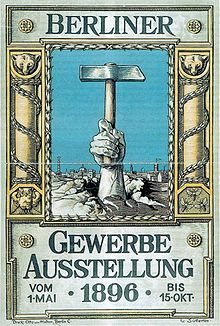Great Industrial Exposition of Berlin
| EXPO Berlin 1896 | |
|---|---|
 |
|
| Overview | |
| BIE-class | Unrecognized exposition |
| Name | Berliner Gewerbe Ausstellung |
| Building | Archenhold observatory |
| Invention(s) | X-Ray |
| Visitors | 7,000,000 |
| Participant(s) | |
| Business | 3,780 |
| Location | |
| Country | Germany |
| City | Berlin |
| Venue | Treptower Park |
| Coordinates | 52°29′25″N 13°28′12″E / 52.49028°N 13.47000°E |
| Timeline | |
| Opening | 1 May 1896 |
| Closure | 15 October 1896 |
| expositions | |
| Previous | World's Columbian Exposition in Chicago |
| Next | Brussels International (1897) in Brussels |
The Great Industrial Exposition of Berlin 1896 (German Große Berliner Gewerbeausstellung 1896) was a large exposition that has also been dubbed "the impeded world fair" (in German "Die verhinderte Weltausstellung").
Under the official name of a Berlin Industrial Exposition (German "Berliner Gewerbeausstellung") - borrowing the name from earlier exhibitions - the Universal Exposition of Berlin took place between May 1 and October 15, 1896 in the Treptow borough of Berlin.
The first Berlin Industrial Exposition was initiated by the Prussian Minister Christian Peter Wilhelm Beuth. The trade fair took place from September 1 to October 15, 1822, as an exhibition of regional trades in the House of Industries in the Kloßterstraße. There were 182 exhibition companies showing 998 different products to 9514 visitors. The second trade fair took place in 1827 at the same place.
In 1844 the General German Industrial Exhibition (in German Allgemeine Deutsche Gewerbe-Ausstellung) took place in the old arsenal house, the Zeughaus of Berlin. Among 3040 exhibition companies there were 685 Berlin companies showing a large variety of German industrial goods - the exhibition saw 260,000 visitors.
In 1879 a large exhibition was set in an exhibition park created near the Lehrte Station. The exhibition was not only a show of technological advancements but it was also created as an amusement park.
One of the main attractions of the event was the first electric locomotive from Siemens & Halske. Originally built for use in a coal mine, it pulled three small cars fitted with wooden benches, each car being capable of carrying six passengers for a ride along a 300-meter circular track. Electrical power was supplied to a third rail from a nearby generating station. During the four months of the exhibition, it carried 90,000 passengers. The original locomotive is now displayed at the Deutsches Museum in Munich and a replica is shown at the German Museum of Technology (Berlin).
After the successful world fairs in London and Paris the Berlin press argued at large for a world fair to be held in Berlin as well. Especially the "Verein Berliner Kaufleute und Industrieller" (Association of Merchants and Industrialists) was on the forefront - the association had been founded for the industrial exposition of 1879. Its chairman Max Ludwig Goldberger took it as a personal aim of life to make a world fair happen in Berlin. Goldberger had lived in the USA for a time and he had written a book called "Land der unbegrenzten Möglichkeiten" (literally "country of boundless possibilities", the German wording for the catch phrase of "the land of opportunity"). He knew quite well of the international benefits for the industry deriving from a world fair. With the Eiffel Tower showing the industrial strength on the world fair in Paris of 1889 the national press was nearly frantic about a German world fair to show off to the "Erbfeind" (hereditary enemy).
...
Wikipedia
